Popular games for platform Fairchild Channel F
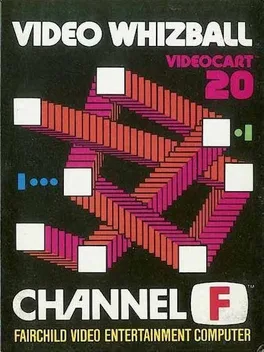
Video Whizball is a game where players control paddles that have to protect a goal from being entered by whizballs. To protect their goal, the player's paddle can fire missiles which can be aimed straight or angled up or downward. Missiles that hit whizballs can help propel them to start going in an opposite direction. If one of the missiles or whizballs hits the player's or the opponent's paddle, it will temporarily disappear leaving the respective goal undefended. The game is won when either one of the players gets to a previously selected score. The game contains 72 game variations of this basic premise. Variations include having from 1 to 4 whizballs, and 6 different game types: Basic: each whizball is worth only 1 point; Basic Plus: players can guide the missile shots into the whizballs; Bonus: whizballs can be numbered 1 through 4 and are worth that many points each; Bonus Plus: adds guided missiles to the Bonus game type; Super Bonus: whizballs increase in value from 1 to 9 points the longer they stay in play; Super Bonus Plus: adds guided missile shots to the Super Bonus game type. This preprogrammed cartridge plugs into the console of the Fairchild Video Entertainment System for more TV fun on the Channel F Network. Imagine shooting pool with both players going for the balls at the same time. That's just a hint of the slam-bang action you'll find as you try to knock the whizballs into your opponent's goal.
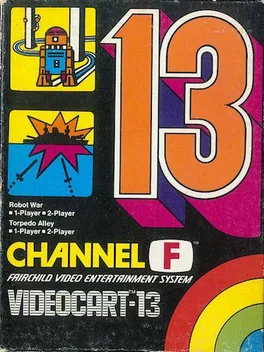
This cart contains two different games. The first game is Robot War. It takes place on a space station. The computer malfunctioned and now four robots are out to hunt down the player. Gameplay mainly has the player trying to trick the pursuing robots into one of the four electrified force fields littered throughout the playfield. Every time the player is touched by a robot, one of the force fields disappear. Once all the force fields disappear, the player loses a point to the robots. If all the robots are defeated, the player gets a point for that round. The game also features an option for two players, where the second player takes control of the robots. The game features four game speeds from slowest to fastest The other game is Torpedo Alley. Players control a shore battery at the bottom of the screen and shoot at an invading fleet of ships above them. Each hit ship is worth a different amount of points, with the lowest ship being worth 1 point, the middle ship worth 3 points, and the highest ship worth 5 points. The game ends when a player reaches 99 points or the adjustable time limit expires. This preprogrammed cartridge plugs into the console of the Fairchild Video Entertainment System for more TV fun. The hunter or the hunted. Take your choice in these action-packed one and two-player games.
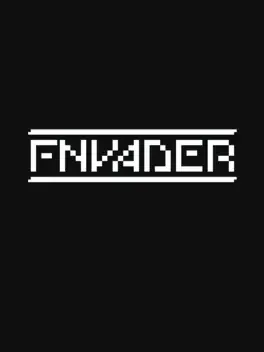
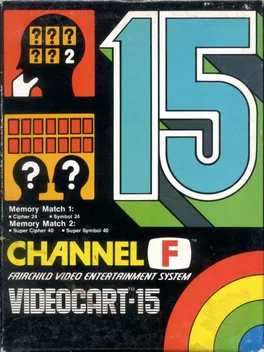
Memory Match is a game where the player is given the task of flipping over cards two at a time in the hopes of having them match. If the cards match, they disappear from the playfield. If they don't match, the cards are flipped back over face down and the player tries again. The better the player is at memorizing where the overturned cards were, the easier it will be for him to find a match. The game contains 4 variations of its basic premise. The Memory Match 1 variations offer a smaller grid thus making it easier. Memory Match 1: Cipher-24 (6x4 grid with numbers) Symbol-24 (6x4 grid with symbols) Memory Match 2: Super Cipher-40 (10x4 grid with numbers) Super symbol-40 (10x4 grid with symbols) The game offers both 1 and 2-player modes. When playing alone, the player tries to clear the board in the fewest amount of guesses. In the multiplayer, both players try to get more matches than their opponent.
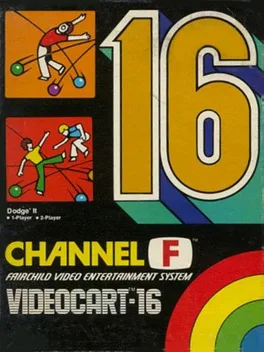
The gameplay featured on this cart is a take on the game of Dodgeball. The player is trapped inside a playfield and has to dodge a ball that continuously keeps bouncing of the sides of the playfield. The longer the player is able to dodge the ball, the more points are earned. After a certain amount of points are earned, another ball enters the playfield thus making the player have to dodge two balls. More balls keep getting added at fixed intervals after that until a total of 9 balls are in the playfield. The game ends when the player is finally hit by the ball. In the 2 player game, both players are put into the same playfield and try to outlast the other player in trying not to get hit by the balls being thrown by the computer. The game features random variations in the gameplay, such as having different sized playfields, ball sizes and speeds, and changing the players' size and speed. There's an Amateur and a Pro mode, both playable with either 1 or 2 players. This preprogrammed cartridge plugs into the console of the Fairchild Video Entertainment System for more TV fun. It's like the old playground favorite dodge ball. Only this time the computer's throwing the balls, not your classmates.

Although the title of the game may lead players to believe it's a pinball game, this is actually a Breakout variant. The basic gameplay features the player bouncing a ball off of a paddle into a wall of bricks, chipping them off one brick at a time. Each brick destroyed earns the player points with the low green bricks being worth 1 point each, the middle blue bricks being worth 4 points each, and the red bricks on top rewarding 7 points each. Once the ball bounces off the wall of bricks, it's up to the player to maneuver the paddle under the falling ball in order to hit it back up into the wall of bricks. The player loses a life if he happens to miss hitting the ball with his paddle and it falls into the abyss. The game ends when 7 balls are lost. To keep up with the pinball motif, the wall of bricks are referred to as different colored skill lanes, the walls on the side that the ball can bounce off of are labeled side rails, and the paddle is referred to as a flipper. The game offers 132 game variations of this basic gameplay idea, some of them for two simultaneous players. Game modes include Pinball Wiz, Crossover, Blok-Shot, Cooperation, Pro Challenge, and Double Blok, with each having variations that can include different sized paddles, ball speeds, invisible bricks, and even a variation where the paddle shrinks each time it hits the ball. This preprogrammed cartridge plugs into the console of the Fairchild Video Entertainment System for more TV fun. Pinball wizards get ready for a real tilt. You'll flip over these 132 game variations for 1 and 2 players.
This is the classic modern-day mobile puzzle game 2048. The aim is to create a block containing the number 2048. When you move the controls in a direction, the blocks will move in that direction until they hit another block or the edge of the grid. When a moving block meets a stationary block of the same value, they combine to create a block with double the value, which clears space on the grid. Every time you make a move a new block is randomly placed on the grid, usually this will be a 2 but sometimes can be a 4. Should the grid fill up and there are no adjacent blocks of the same value to combine, the game is over and you will need to press the reset button. Game Modes: 2048 - the game finishes when you achieve a block with a value of 2048. Try and achieve this in the quickest time possible! Long - the game continues until you create the largest block possible of 131,072 or there are no more moves available. Time - you have three minutes to achieve the highest score you can.
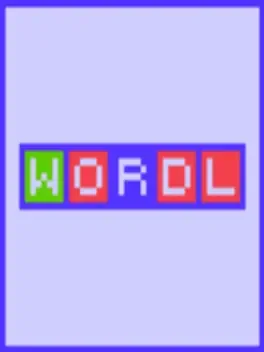
I couldn't allow the port old Fairchild Channel F, the first games console to use ROM cartridges, to be left out of the Wordle craze. This ground-breaking machine, offering colour graphics in the home in 1976 when state-of-the-art arcade games were mostly monochrome until 1979, was unfortunately made obsolete with the arrival of the 2600 less than a year later. This version features 1,175 built-in words (max ROM size is 8K). Obviously as a result it cannot check the answers you enter are valid words, so it's up to you whether you play an honest game or not...! Hint: None of the words in the list have the same letter more than once.
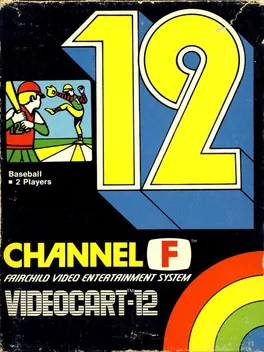
One player takes to the field, the other grabs a bat and steps up to the plate. The pitcher can throw fast, slow, and some wicked curves even at the last moment. Luckily the single-button swing action makes hitting the ball fairly easy, even if getting a single is harder than hitting a double or home-run. This preprogrammed cartridge plugs into the console of the Fairchild Video Entertainment System for more TV fun. Our Baseball game gives you nine (or more) innings to practice your timing, mix-up your pitches, shift your outfield... major league thrills with the comforts of home. (Tinkers to Evers never had such a Chance!)
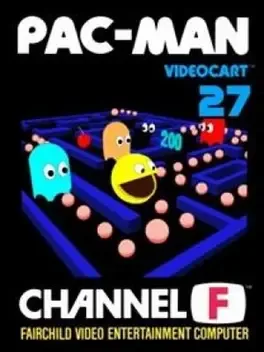
An unauthorized version of Pac-Man. Pac-Man is a game where the eponymous Pac-Man goes around a maze in the cardinal directions munching pellets as he goes. The goal is to eat all the pellets found on the maze. While trying to do this, Pac-Man is harassed by four ghosts (Blinky, Pinky, Inky, and Clyde) who constantly chase him around the maze. If the ghosts touch Pac-Man, he will lose a life. Pac-Man starts with three lives and if he loses all of them the game will end. Pac-Man is not completely defenseless as on each maze, there are four power pellets, that when Pac-Man consumes them, will cause the tides to turn, as Pac-Man will be able to temporarily chase the ghosts to eat them and temporarily send them back to the middle of the maze from whence they came. Pac-Man can also eat randomly appearing fruit to earn bonus points. This version of Pac-Man retains the intermissions found in the original game.
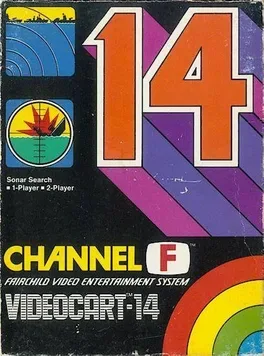
Sonar Search features the basic gameplay idea of Battleship, but with a unique twist. Instead of trying to randomly guess what grid an opponent's battleship is on, after the player takes a shot, the player will hear a sonar ping noise. The shorter the noise, the closer the player is to hitting a target. In the 1 player game, the player has a limited number of chances to sink the enemy fleet of ships, while in the 2 player game, players take turns trying to sink their opponents ships before having their own ships sunk. This preprogrammed cartridge plugs into the console of the Fairchild Video Entertainment System for more TV fun. This battle on the high seas is sure to score a direct hit with exciting one and two-player games.
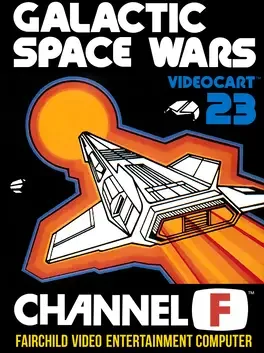
In Galactic Space Wars, the player controls of a fighter spacecraft with the sole objective to find and destroy enemy space ships. The players takes a first person perspective from inside the cockpit searching the vast area of space to locate enemy craft. Once one is located, players try to quickly fix their laser's sight on the enemy and shoot it. If the enemy stays on the screen for too long, it will fire one shot at the player's ship and score a hit. There are four different enemy ships, each worth a varying amount of points. Players are given a limited amount of time to destroy as many ships as possible, while trying not to let the enemy ships fire back. Lunar Lander is inspired by the same titled arcade game Lunar Lander. Players pilot a lunar lander and attempt to have a soft landing on a platform. The lunar lander has a limited amount of fuel to maneuver around, thus adding to the challenge. Players must gently and smoothly lower the lander onto the platform, as coming down too fast or missing the platform crashes the lunar lander. There is also a timer keeping count of the amount of time it takes for the player to land. The objective is to land the craft in the least amount of time possible.

A port of the 1975 PC-50X Game Submarine, similar type games were also in the arcade and are ports themselves from Electromechanical games. Choose either the Submarine (Blue) or Destroyer (Green) and attempt to shoot each other with missiles. Submarine can also hit the Escort (Red) ship that is protected by the Destroyer. Plunging down the controller fires, Push Left / Right for Left and Right movement on screen respectively. Game ends when one side reaches 15 points.
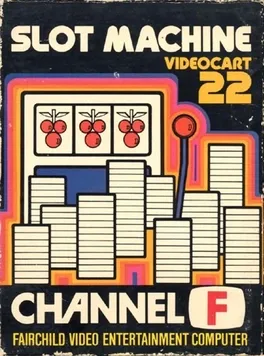
In this slot machine simulation, the player can choose the starting purse (from 1-99 USD) and then bet on each spin of the slot reels. The game offers two modes: Random play lets the wheel spin and then stop randomly, and select play lets the player choose when to stop each wheel at a time.
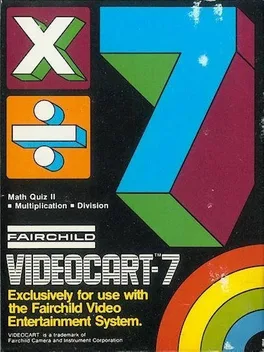
Videocart-7: Math Quiz (Multiplication & Division) is a Triva/Game/Quiz Show video game released by Fairchild Semiconductor for the Fairchild Channel F in 1977. This preprogrammed cartridge plugs into the console of the Fairchild Video Entertainment System for more TV fun. Get one problem right and a new one appears. Take turns with a buddy to double the competition... And quadruple the fun!
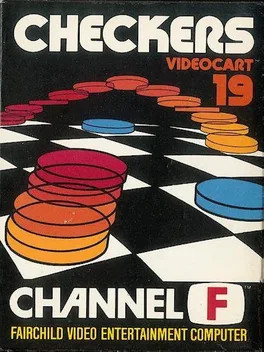
A playable version of the board game of Checkers. The player controls the 12 checkers at the bottom of the screen and attempts to remove the 12 checkers at the top of the screen, controlled by the computer. A player can only move his checkers diagonally toward his opponent's side of the board. A checker can be jumped when two opposing checkers are adjacent to each other and there is an empty space directly across the checker being jumped. If there's a checker in the board that a player can jump, he is forced to do so. If a checker reaches the other side of the board, that checker is kinged and is allowed to move and jump both back and forth in diagonal movements. The game is won by the player who removes all of his opponent's checkers from the board. This preprogrammed cartridge plugs into the console of the Fairchild Video Entertainment System for more TV fun on the Channel F Network. The classic game of checkers is played against the computer. Here is your chance to sharpen your skills without your opponent dumping the checkerboard on your head. Check it out.
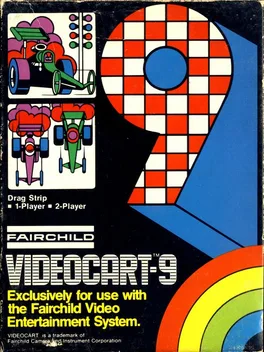
This drag racing simulator makes use of the Channel F's special controllers. While twisting the joystick's head to the left or right controls the engine throttle, the stick movement itself is used to shift gears in a realistic H-pattern. Depending on the chosen skill level, the car available is a family sedan, a modified sedan, a funny car, or a real dragster, although they all look the same on screen. One player can try to beat the predefined par time of 7.7 seconds, or compete against a friend to see who reaches the finish line first. The game manual mentions that a player only wins the game when he brings his victory counter to 99. This preprogrammed cartridge plugs into the console of the Fairchild Video Entertainment System for more TV fun. Know when to shift and you'll go the distance with these 2 racy games. But careful... Redline your engine, an dyou wind up shiftless! (You've blown it!)

A one- or two player puzzle game published and developed in 2004. This is an unofficial homebrew of Tetris for the Fairchild Channel F.

A deceptively simple puzzle game written for the Fairchild Channel F. The aim of the game is to place a tent adjacent to each tree in such a way that the correct number are in each row and column, as shown by the numbers alongside. When you have the correct number in a particular row or column, the number will turn green. Tents cannot be placed if there is no tree to the left, right, above or below.

In this Space Invaders variant, the player controls a gun turret at the bottom of the screen and fires missiles at incoming alien ships. The turret can move both left and right and hide behind three protective barriers. The alien invaders move left and right, fire missiles at the player, and slowly approach the planet surface - if they land, the player loses the game. Every once in a while, an alien mothership will fly across the top of the screen and shooting it will give the player extra points. The goal of the game is to destroy all alien ships in each attacking wave and score as many points as possible. The game ends when players lose their three lives.

Videocart-6: Math Quiz (Addition & Subtraction) is a Triva/Game Show video game released by Fairchild Semiconductor for the Fairchild Channel F in 1977. This preprogrammed cartridge plugs into the console of the Fairchild Video Entertainment System for more TV fun. Get one problem right and a new one appears. Take turns with a buddy for added competition... Plus or minus some fast-paced fun.
